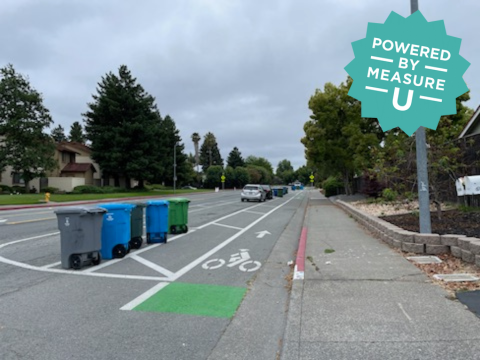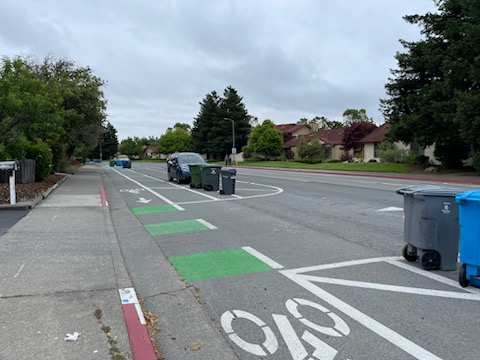Rainier Avenue Paving & Traffic Calming Upgrades
Project Description
This project is made possible by funding from Measure U - a community-supported revenue measure.
Creating safer streets is top priority for us here at the City of Petaluma. Since September 2021, we have been seeking community input on ways to make Rainier Avenue safer. Rainer is scheduled to receive significant upgrades from North McDowell Blvd. to Sonoma Mountain Parkway. Upgrades will include:
- Replacement of water services (underground water pipes)
- Pavement restoration (repaving)
- Traffic, bicycle, and pedestrian safety upgrades
WHAT WE’VE DONE SO FAR
Trial Demonstration Project
In August 2022, we installed a trial demonstration project on Rainier Ave. from N. McDowell Blvd. to Maria Drive, which includes temporary elements like paint and rubber barriers. This gave the community a chance to experience proposed changes to the road and provide feedback, and for City engineers and police to gather important safety data. All of this helps inform the design of more permanent solutions.
Demonstration project elements:
- Reduced traffic lanes from 4 to 3, with one lane in each direction and a left turn lane in the middle
- Added a parking protected bike lane on the north side of the road
- Added a 3-foot buffer between the parking lane and travel lane on north side of road
- Added a buffered bike lane on south side of road (parking removed)
COMMUNITY INPUT
We have been seeking community input since September of 2021, with significant community engagement taking place before and after the installation of the demonstration project. Outreach has included:
- Mailers
- Virtual Community Workshop
- Website form
- Neighborhood Meeting
- Social media posts
- Online surveys
Below are links to notes and videos of our Virtual Community Workshop:
- CLICK HERE to view notes recapping the workshop and input from the public.
- CLICK HERE to view a recording of the workshop.
- CLICK HERE to view the presentation shared during the workshop.
CLICK HERE to view the responses from the webform.
Thank you to all who took the time to engage in this crucial conversation with us. Rainier is an important road in Petaluma and our goal is to make it the best it can be for all users and residents. Your feedback is valuable tool in our process.
WHAT WE’VE SEEN & HEARD
Since the demonstration project was installed, we have tracked safety data and received feedback from the community.
- Safety Data:
- Demonstration Stretch (Maria Drive to N. McDowell Blvd)
- 72% of drivers complying with 35mph speed limit
- Top speed recorded: 45mph
- Demonstration Stretch (Maria Drive to N. McDowell Blvd)
-
- Non-Demonstration Stretch (north of Maria Drive)
- 48% of drivers complying with 35mph speed limit
- Top speed recorded: 50mph
- Non-Demonstration Stretch (north of Maria Drive)
-
- No adverse congestion impacts were observed or reported anywhere on Rainier Avenue
Community Feedback
- Challenges seeing oncoming traffic when pulling out of driveways
- Complaints about difficulty entering/exiting parked cars on driver’s side due to proximity of travel lane
- Generally unpopular with drivers – opposition to lane reduction, unfamiliarity with new configuration
- Popular with people using bicycles
Presentation to City Council
We presented safety data and community feedback to City Council as part of our Active Transportation workshop on October 16, 2023. At that meeting, City Council directed staff to “harden” or permanently install the demonstration configuration.
NEXT STEPS
Rainier is scheduled to receive upgrades to underground utility pipes (water services) in the summer of 2025. The City will also install a recycled water pipe that will supply recycled water to the parks and schools in the area.
After the utility work is complete, we will do a full road reconstruction on Rainier Avenue. This will provide a smooth road surface and give us the opportunity to install permanent safety upgrades. We will share and seek input on the final roadway design with the community as we get closer to construction, currently estimated to occur in early 2026.
We recently made updates to the current demonstration project to ensure it is easily visible until the permanent changes are installed.
Read on for details on the water services and paving work.
Project Manager
Project Location
The project will take place on Rainier from North McDowell Blvd. to Sonoma Mountain Parkway.
Traffic Impacts & Benefits
There will be minor delays during construction. When completed, the project will help keep the road protected and ensure more extensive reconstruction will not be required in the future and will offer improved safety conditions for motorists, bicyclists, pedestrians and those with limited mobility.
Timeline/Project Status
Tentative schedule (dates subject to change):
- August 2022: Demonstration Project installed & community survey launched
- December 1, 2022: Survey closes
- December 7, 2022: Project team presented survey results and traffic data to Pedestrian & Bicycle Advisory Committee
- October 16, 2023: Project team presented survey results and traffic data to City Council
- Spring 2024: Water services replacement underground work to commence
- Summer/Fall 2024 (Dates TBD): Final roadway configuration to be installed following paving project
- Summer/Fall 2024: Final active transportation build-out, including striping, crossings, and other bike/ped improvements to be installed immediately upon completion of paving
Council Goals and Priorities
This project reflects the following City goals, with Safe Streets/Safe Mobility being one of the top ten City Council priorities.
A CITY THAT WORKS FOR EVERYONE
- Provide City infrastructure that is safe, sustainable, multi-use, efficient, inspiring civic pride.
- Establish and improve paths, as useful transportation options, and make walking and biking easy, fun, and safe.
- Better integrate multi-modal transportation with street designs
A SAFE COMMUNITY THAT THRIVES
- Maintain and enhance public safety and prepare for emergencies and disasters, through crime and fire prevention, and traffic safety.
- Implement City Vision Zero plan with a focus on pedestrian and cyclist safety with improvements to uncontrolled crosswalks, curb ramps, sidewalk, and bicycle infrastructure.
- Enhance pavement management program to improve the safety and serviceability of our roads to protect drivers, cyclists, and pedestrians.
This project will help meet our Climate Action goals by allowing roadway users to feel more comfortable and safer walking and riding bikes. Also, this project helps to implement safer routes to nearby schools.
Funding
Funding is provided by California State Senate Bill 1 (SB 1), the Road Repair and Accountability Act of 2017 supported by the gas tax, and Measure U, a community-supported revenue measure.
Rainier FAQ's
Over the course of community outreach, there were some common questions and concerns that were raised. The following FAQs respond to what we’ve heard from the community. If you have additional questions or concerns, please contact project manager, Ken Eichstaedt, Senior Traffic Engineer.
- How does the demonstration project design increase safety?
- How do the changes to Rainier Avenue effect on-street parking?
- Will this project increase traffic volumes on other nearby streets?
- How do the changes to Rainier Avenue affect parked cars?
- Why is the demonstration project design safest for cyclists of all ages and abilities?
- How do the changes impact street cleaning, garbage pick-up, and mail delivery on Rainier Avenue?
- Does the project enable the planting of street trees?
- Why are you not proposing a two-way bikeway on the south side of Rainier Avenue?
- Are appropriate sight lines available for drivers entering or leaving a driveway?



